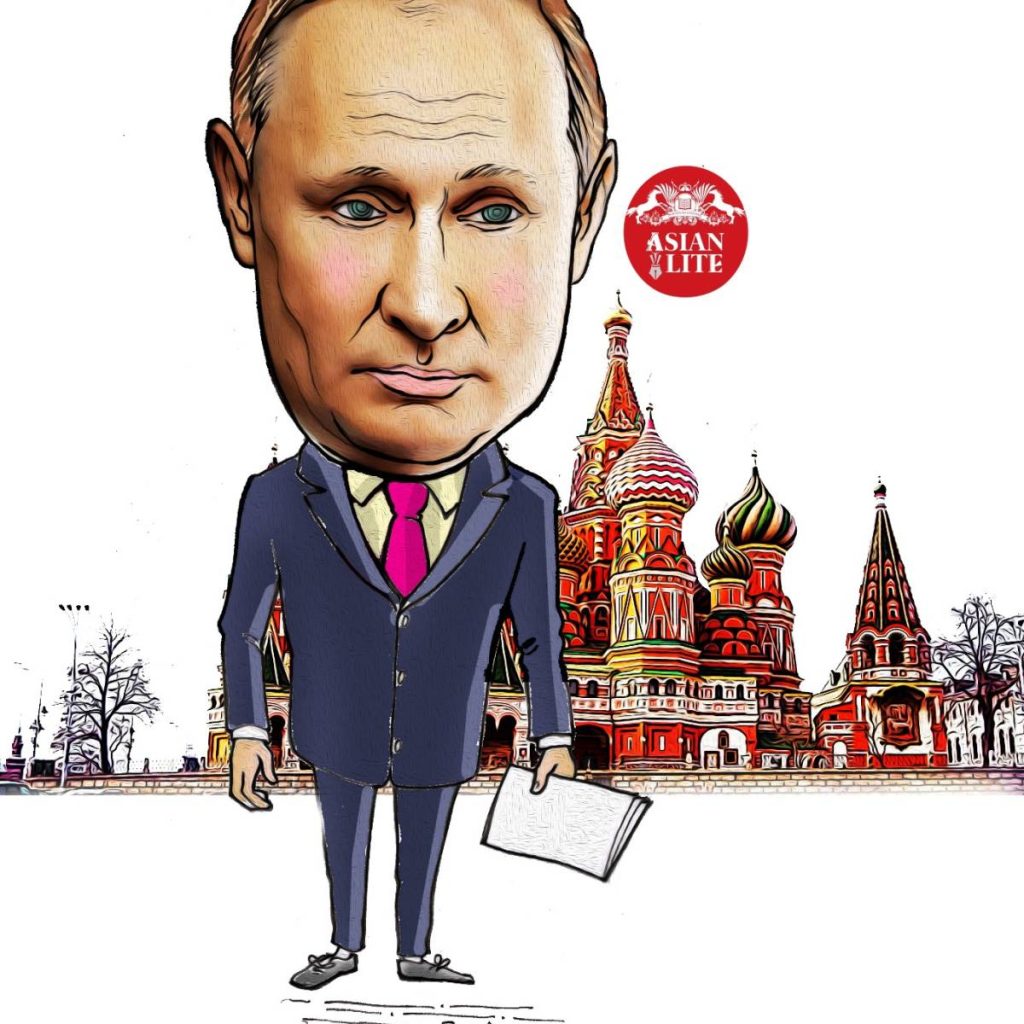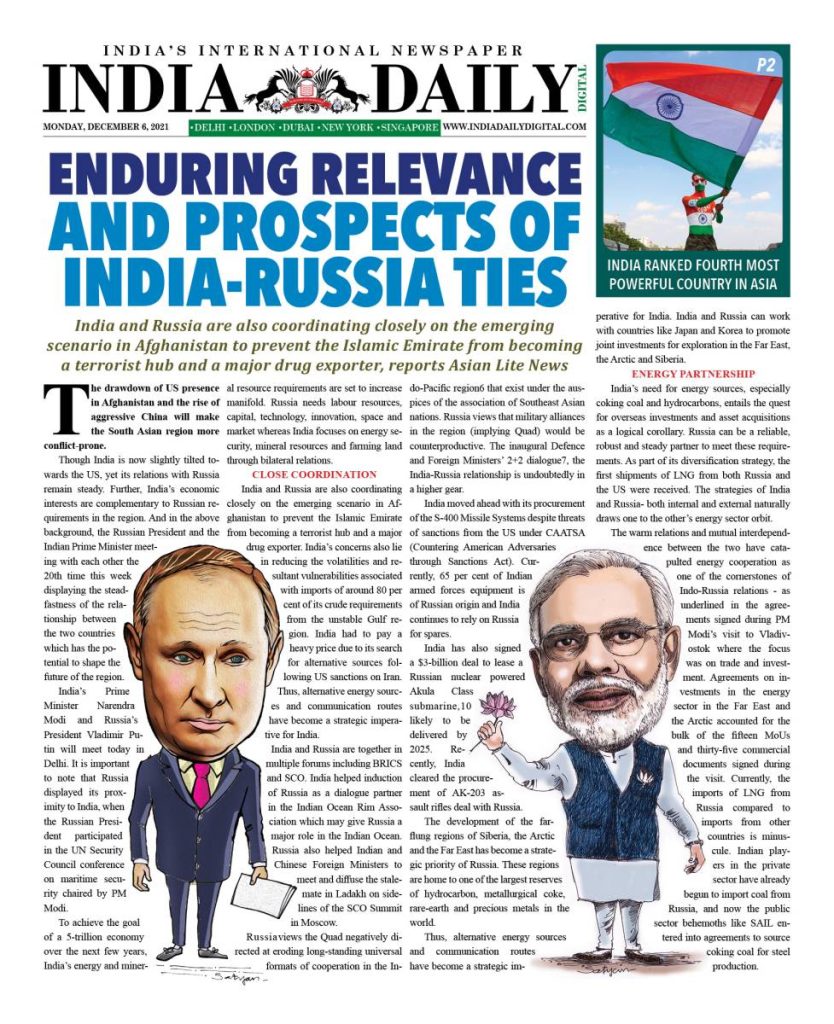India and Russia are also coordinating closely on the emerging scenario in Afghanistan to prevent the Islamic Emirate from becoming a terrorist hub and a major drug exporter reports Asian Lite News
The drawdown of US presence in Afghanistan and the rise of aggressive China will make the South Asian region more conflict-prone. Though India is now slightly tilted towards the US, yet its relations with Russia remain steady. Further, India’s economic interests are complementary to Russian requirements in the region. And in the above background, the Russian President and the Indian Prime Minister meeting with each other the 20th time this week displaying the steadfastness of the relationship between the two countries which has the potential to shape the future of the region.

India’s Prime Minister Narendra Modi and Russia’s President Vladimir Putin will meet today in Delhi. It is important to note that Russia displayed its proximity to India, when the Russian President participated in the UN Security Council conference on maritime security chaired by PM Modi.
To achieve the goal of a 5-trillion economy over the next few years, India’s energy and mineral resource requirements are set to increase manifold. Russia needs labour resources, capital, technology, innovation, space and market whereas India focuses on energy security, mineral resources and farming land through bilateral relations.
Close coordination
India and Russia are also coordinating closely on the emerging scenario in Afghanistan to prevent the Islamic Emirate from becoming a terrorist hub and a major drug exporter. India’s concerns also lie in reducing the volatilities and resultant vulnerabilities associated with imports of around 80 per cent of its crude requirements from the unstable Gulf region. India had to pay a heavy price due to its search for alternative sources following US sanctions on Iran. Thus, alternative energy sources and communication routes have become a strategic imperative for India.
India and Russia are together in multiple forums including BRICS and SCO. India helped induction of Russia as a dialogue partner in the Indian Ocean Rim Association which may give Russia a major role in the Indian Ocean. Russia also helped Indian and Chinese Foreign Ministers to meet and diffuse the stalemate in Ladakh on sidelines of the SCO Summit in Moscow.
Russia views the Quad negatively directed at eroding long-standing universal formats of cooperation in the Indo-Pacific region6 that exist under the auspices of the association of Southeast Asian nations. Russia views that military alliances in the region (implying Quad) would be counterproductive. The inaugural Defence and Foreign Ministers’ 2+2 dialogue7, the India-Russia relationship is undoubtedly in a higher gear.
India moved ahead with its procurement of the S-400 Missile Systems despite threats of sanctions from the US under CAATSA (Countering American Adversaries through Sanctions Act). Currently, 65 per cent of Indian armed forces equipment is of Russian origin and India continues to rely on Russia for spares.
India has also signed a $3-billion deal to lease a Russian nuclear powered Akula Class submarine,10 likely to be delivered by 2025. Recently, India cleared the procurement of AK-203 assault rifles deal with Russia.
The development of the far-flung regions of Siberia, the Arctic and the Far East has become a strategic priority of Russia. These regions are home to one of the largest reserves of hydrocarbon, metallurgical coke, rare-earth and precious metals in the world.
Thus, alternative energy sources and communication routes have become a strategic imperative for India.
India and Russia can work with countries like Japan and Korea to promote joint investments for exploration in the Far East, the Arctic and Siberia.
Energy partnership
India’s need for energy sources, especially coking coal and hydrocarbons, entails the quest for overseas investments and asset acquisitions as a logical corollary. Russia can be a reliable, robust and steady partner to meet these requirements. As part of its diversification strategy, the first shipments of LNG from both Russia and the US were received. The strategies of India and Russia- both internal and external naturally draws one to the other’s energy sector orbit.

The warm relations and mutual interdependence between the two have catapulted energy cooperation as one of the cornerstones of Indo-Russia relations – as underlined in the agreements signed during PM Modi’s visit to Vladivostok where the focus was on trade and investment. Agreements on investments in the energy sector in the Far East and the Arctic accounted for the bulk of the fifteen MoUs and thirty-five commercial documents signed during the visit. Currently, the imports of LNG from Russia compared to imports from other countries is minuscule. Indian players in the private sector have already begun to import coal from Russia, and now the public sector behemoths like SAIL entered into agreements to source coking coal for steel production.
In the absence of a direct land route, transportation becomes a real challenge for trade between India and Russia. The International North-South Transport Corridor will take years to become fully operational. In 2020, both countries have agreed to develop the Vladivostok-Chennai sea route, which will cut down the journey time of large ships from about 40 to 24 days. Russia is becoming India’s one of the most important oil and gas investment destinations. Russian Oil Company Rosneft bought Essar Oil for $12.9 billion.
Earlier, India also extended $1 billion Line of Credit (LoC) for exploration in the resource-rich Far Eastern region-the first-ever region-specific LoC by India. A big breakthrough in terms of movement of Indian labour – both skilled and semi-skilled is also on the cards. In 2019-20, the trade between the two countries was $10.11 billion but the two countries have set a trade target of $30 billion by 2025.
Negotiations for the India-Eurasian Economic Union (EAEU) Free Trade Agreement, which could boost trade, was also commenced in 2020.
India and Russia can work with countries like Japan and Korea to promote joint investments for exploration in the Far East, the Arctic and Siberia. The ports of northeast Asia and southeast Asia can act as transit points for movement and off-loading LNG en-route India.

However, a lot of spadework needs to be done by both countries. Russia needs to liberalise its services and visa facilitation regimes further to facilitate the hassle- free movement of Indians. The visa-regulations are much easier for Chinese than it is for Indians. India has slashed Customs duties on LNG imports, but issues pertaining to the valuation of gas, dedicated berthing facilities at ports, especially along the eastern coastline, eventually need to be addressed.
The Far East and the Arctic have geopolitical, economic and strategic significance for India. The development of the North Sea Route along the Arctic coast can provide an alternative to the existing Suez Canal route. India should not be left behind and must have robust economic and strategic footprints in these regions. In this forthcoming Summit, a logistics support pact between the armed forces of the two countries, on similar lines as India-US, Indo-Japan, is expected to be inked besides a number of trade and technology agreements.
Vaccine pact
Under vaccine diplomacy to fight the global Covid-19 pandemic, both countries came together. The upcoming visit, though short and among the few by President Putin since the pandemic took hold, would surely strong way forward with shared vision for future.
ALSO READ-Correcting the India-Russia narrative ahead of Putin’s visit

